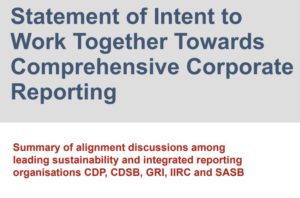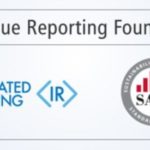
Transparent measurement and disclosure of sustainability performance is now considered to be a fundamental part of effective business management, and essential for preserving trust in business as a force for good. Yet, the complexity surrounding sustainability disclosure has made it difficult to develop the comprehensive solution for corporate reporting that is urgently needed. In response to this, five framework- and standard-setting institutions of international significance, CDP, the Climate Disclosure Standards Board (CDSB), the Global Reporting Initiative (GRI), the International Integrated Reporting Council (IIRC) and the Sustainability Accounting Standards Board (SASB), have co-published a shared vision of the elements necessary for more comprehensive corporate reporting and a joint statement of intent to drive towards this goal – by working together and by each committing to engage with key actors, including IOSCO and the IFRS, the European Commission, and the World Economic Forum’s International Business Council.
GRI, SASB, CDP and CDSB set the frameworks and standards for sustainability disclosure, including climate-related reporting, along with the TCFD recommendations. The IIRC provides the integrated reporting framework that connects sustainability disclosure to reporting on financial and other capitals. Taken together, these organisations guide the overwhelming majority of sustainability and integrated reporting.
Through this paper, the five organisations outline a shared vision that includes both financial accounting and sustainability disclosure, connected via integrated reporting. As Charles Tilley, CEO of the IIRC, says, “This year we have witnessed businesses around the world having to pivot their business models overnight, to prioritize the health and safety of their employees and customers above the immediate financial success of the business. The connectivity between sustainability-related factors and immediate financial-viability is clearer than ever before. It is why we are committed to working with our partners to drive a holistic system for reporting across the value chain. We know that businesses globally are already using a mixture of our frameworks and standards to provide stakeholders with robust, effective information to drive better decision-making and capital allocation via their integrated report. This document provides further clarity on how to do this effectively.”
Foundational to this vision is multi-stakeholder standard-setting that greatly reduces the burden on reporting organisations while facilitating analysis, interpretation and action by users of information. As Eric Hespenheide, Chair of the GRI Board, says: “We are pleased to be collaborating with our peers in the sustainability frameworks and standard setting community, and see this joint statement as a powerful interim step. As GRI, we believe strongly in a vision of a single, coherent global set of reporting standards, and will be working with others to achieve this outcome. We look forward to continuing to work together with all interested organizations in achieving greater transparency through disclosure in the weeks and months to come.”
Users of sustainability disclosures have many various needs, which sustainability disclosure standards are designed to facilitate. In addition to understanding the impacts on society and the environment associated with an organisation’s activities, many users need to understand how these issues affect the organisation’s financial performance and long-term enterprise value creation. As Janine Guillot, CEO of SASB says, “SASB’s unique role in this system is to surface the subset of environmental, social, and governance issues reasonably likely to materially impact financial performance of the typical company in each of 77 industries. SASB Standards are designed to improve the quality and comparability of a core subset of financially material sustainability information, serving as an important complement to information that is already reflected in the financial accounts according to Financial GAAP.”
Acknowledging the importance of structured information to enable comparison, the standardsetters emphasise the importance of data being structured around agreed taxonomies and being democratised via a public data platform, as CDP provides for thousands of companies.
Paul Simpson, CEO of CDP explains, “We are delighted to work with these peer organisations to develop this statement. Over the past 20 years at CDP, we have seen environmental disclosure move from being almost non-existent to fully mainstream. The 8,400 companies, representing over 50% of global market capitalisation, who disclosed through our platform last year demonstrate this and provide a structured data set to the market. With the world’s largest corporate environmental disclosure repository, CDP is uniquely placed to showcase which data points align with which standards and taxonomies, and to continue to help companies, cities, states and regions to measure their environmental risks, opportunities and progress.”
The joint statement from this group shows a commitment to engage with all stakeholders to achieve the globally accepted comprehensive corporate reporting system that is urgently needed. Through the various initiatives and calls for action from many players, including policy makers, there is a groundswell of support for a system change. As Mardi Mcbrien, Managing Director of CDSB, says, “the CDSB Framework is industry agnostic and designed to facilitate effective disclosure of a company’s natural capital, environmental and climaterelated risks and opportunities, so it supports and enhances the work being done elsewhere. This is more than just a statement of intent to work together, it is a natural next step as we look to form a complete picture of how these standards might complement Financial GAAP –integrating with the TCFD. We are looking forward to developing this picture further in the near future to meet the growing demands of investors, governments and consumers globally.”
The joint statement calls for feedback on the ideas expressed in the paper; for engagement with the standard-setters on all parts of the reporting eco-system to increase buy-in and urgent action for change; and for active support and help to achieve and evolve the vision that is set out.
Click here to view the joint statement




